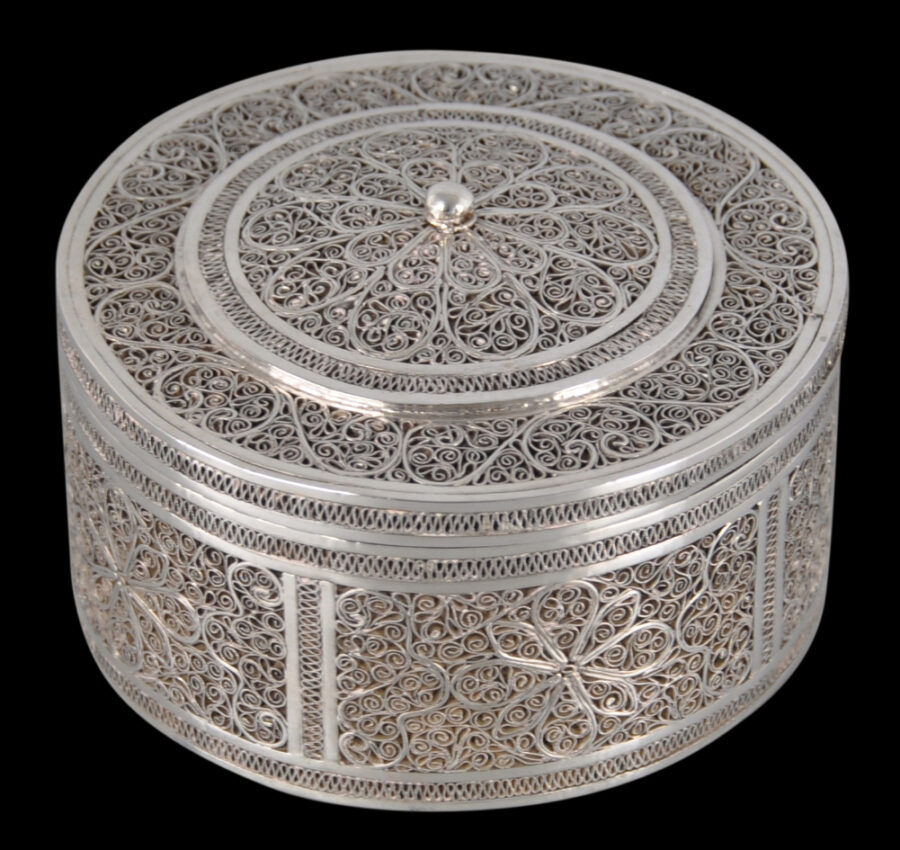This elegant, round box with cover is comprised entirely of silver filigree work, including the base.
The condition is excellent: it is without any losses to the filigree, dents or splits. The lid fits very well and tightly.
The box comprises a cover with a central, raised and doomed panel filled with an open lotus bloom pattern, within a fine, zig-zag border. The sides comprise five panels with similar motifs within more such borders.
The fine craftsmanship extends to the base – it too is made up of fine filigree work rather than being a simple plate of sheet silver.
The filigree features a mixture of flatter, thicker wires that form the outline of the designs, with the remaining spaces being filled with finer, twisted and curled silver wires.
This combination of wide, flattened wire components with fine twisted filigree work is found on articles often ascribed (possibly incorrectly) to Goa of the second half of the seventeenth century – see Menshikova (2006, p. 43) for two examples, and Levenson (2007, p. 263-4) for others. Menshikova refers to filigree items of this type as having been made by ‘Chinese masters in India or Southeast Asia’ in the seventeenth century. More recent research suggests that it was almost certainly made in the Dutch East Indies, either in Batavia or the west coast of Sumatra, most probably at the behest of the Dutch East India Company (VOC). The VOC utilised the work of various silversmithing communities locally, including the local Chinese, local Indians, the Balinese, and almost certainly the Malays of Sumatra (Brinkgreve & Leijfeldt, 2017). Some researchers believe that this type of filigree was produced in India. This might also be the case and certainly examples of this type have been found in India, but one reason for this was because the VOC was known to present silver made in Batavia as gifts to local rulers, but also as an export to local Islamic markets.
Again, the box here is in excellent condition. It has a splendid patina, colour and obvious age.
References
Bennett, J., & R. Kelty, Treasure Ships: Art in the Age of Spices, Art Gallery of South Australia, 2014.
Brinkgreve, F. & J. Leijfeldt, ‘The Chinese-Indonesian collections in the National Museum of World Cultures, the Netherlands’, in Wacana, Vol. 18, no. 2, 2017.
Corrigan, K., J. van Campen, & F. Diercks (eds.), Asian in Amsterdam: The Culture of Luxury in the Golden Age, Peabody Essex Museum/Rijksmuseum, 2015.
Eliens, T.M., Silver from Batavia/Zilver uit Batavia, Gemeentemuseum Den Haag/W Books, 2012.
Jordan, A. et al, The Heritage of Rauluchantim, Museu de Sao Roque, 1996.
Marsden, P., The Wreck of the Amsterdam, Hutchinson, 2nd ed., 1985.
Marsden, W., The History of Sumatra: Containing an Account of the Government, Laws, Customs and Manners of the Native Inhabitants, with a Description of the Natural Productions, and a Relation of the Political State of that Island, 1784.
Parthesius, R., Dutch Ships in Tropical Waters: The Development of the Dutch East India Company (VOC) Shipping Network in Asia 1595-1660, Amsterdam University Press, 2010.
Piotrovsky, M. et al, Silver: Wonders from the East – Filigree of the Tsars, Lund Humphries/Hermitage Amsterdam, 2006.
Veenendaal, J., Asian Art and the Dutch Taste, Waanders Uitgevers Zwolle, 2014.
Voskuil-Groenewegen, S.M. et al, Zilver uit de tijd van de Verenigde Oostindische Compagnie, Waanders Uitgevers, 1998.







